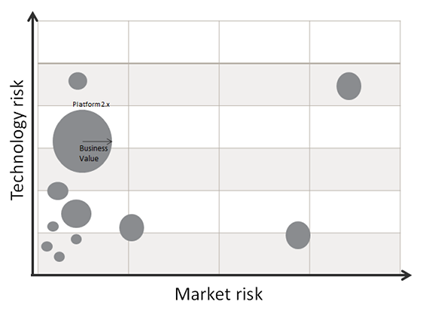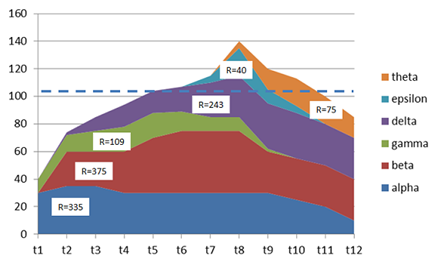Missing the opportunity: The under discovered benefits of Product Portfolio Management.
Product Portfolio Management is a discipline which can deliver great value for a business and ensure the firm gets the best return from its resources and opportunities. However, despite this clear benefit, many businesses either do not even have Product Portfolio Management as a recognisable process or have adopted an ad-hoc methodology.
At the root of this status quo are two factors:
- Businesses can ‘survive’ without Product Portfolio Management.
- Product Portfolio Management is very difficult to do well.
This paper explores these two factors.
Why it’s often not even implemented
It’s often overlooked
Product Portfolio Management is a task which is so deeply integrated into the overall operations of a business that it often is overlooked as a separate competence which needs to be developed and improved in order to make the overall business perform better. In many cases the decisions and choices which should be curated by a Product Portfolio Management function are instead driven by a dominant function (such as Development or Marketing) or alternatively handled without any joined-up ownership on a decision by decision basis.
Its benefits are seen more in the long and medium terms
The choices and decisions driven by portfolio management tend to derive value over some substantial period of time driven by the product development time to market. Therefore in a busy firm, there are always more pressing priorities – be it a product launch or sales firefighting – than to implement a well-structured process for managing the Product Portfolio.
It requires effort to implement well in an organisation
Product Portfolio Management is by its nature a cross functional undertaking requiring full buy-in from participating stakeholder functions. Therefore it is not in itself a new function but a very important process existing in the organisation. While the people tasked with running the process may be hosted by one function or another, it cannot be implemented by a single traditional business function alone.
A growing business does not realise the potential
A business starting out is usually small enough not experience any of the complexity which Product Portfolio Management sets out to clarify. However as business grows, products get added and the business opportunities become more sophisticated, there is a growing increase in complexity and potentially a loss of clear line of sight of on-going product operations. Rather like the metaphorical ‘boiling frog’, the business does not realise that adding structure and process would improve its business results.
‘We’re using Agile we don’t make long term plans’
The popularity of using Agile techniques for software development often creates questions whether any long term plans (such as a portfolio plan) can be made at all. However while Agile does address the issues of making sure a product is ‘about right’ before over-committing resources and not making unrealistic development predictions, there remains a need to allocate resources to different projects and set the overall aims of a product development if not the feature detail.
Why it’s hard to do well
It’s like trying to hit a moving target
Product Portfolio Management is not about meeting the present day requirements of customers and competing against today’s competition rather is it about anticipating future customer requirements and battling against tomorrow’s competition. The longer the new product development cycle the longer the delay between specifying a product and it reaching the market place.
Since predicting the future is not normally a gift bestowed on most human beings, a great deal of effort is required to understand the possible future scenarios and make choices according to that understanding. The aim of Product Portfolio Management is to improve the probability of hitting the target when it is time to market the product.
Developments do not always go as expected
Not only does Product Portfolio Management need to cope with changes in the outside world, there are those changes arising from problems and delays in product development. The result may be that a product is missing attributes associated with its expected success or come to market so late its specification is no longer relevant.
Significant plan changes often precipitate the need to make tough decisions such as a project cancellation or significant re-direction. These are decisions which typically face significant resistance within the organisation and are often unpopular.
It’s often difficult to get functions to commit and co-operate
As a fundamentally cross functional process, success and failure is often tied up with the attitude present in the key contributing functions. It’s a reasonably normal situation than rivalries exist between functions or that hidden agendas exist which may not be aligned with the good of the business as a whole.
A key to success is therefore the ability to inspire stakeholder functions to commit to the common good of the business in an integrated plan.
Getting the balance right in the portfolio
While many aspects of a portfolio are clearly measurable, balance is one aspect which is perhaps more art than science. The term balance can be applied to several aspects of a portfolio design including: the balance between new product development and existing product engineering, the time balance of the portfolio in terms of when products are expected to come to market or the balance across different segments or price points.
At the end of the day, balance is really an informed management judgement which needs to be facilitated by the right information and informed views of the market; it is never a ‘black and white’ decision.
Conclusion
While there are multiple reasons a business does not adopt well defined Product Portfolio Management techniques, in many cases those businesses are missing out on creating a much clearer and strategy linked way to run their businesses. There is no doubt that Product Portfolio Management is a difficult discipline to master but the potential results far out-weigh the effort to implement it.


